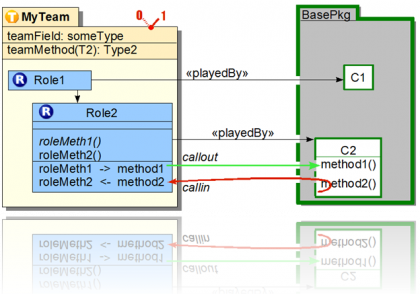Notice: This Wiki is now read only and edits are no longer possible. Please see: https://gitlab.eclipse.org/eclipsefdn/helpdesk/-/wikis/Wiki-shutdown-plan for the plan.
OTJ
Why Object Teams?
Team spirit for your objects
Building complex systems from isolated objects often yields poor structure which readily decays during system evolution. Objects should team-up in order to co-operate and jointly deliver complex behaviors. Objects play specific roles within a given Team.
Context based dispatch
Role instances are attached as specializers to existing objects. Object behavior is controlled by the currently active context that determines which roles are active at a given point in time. Contexts are reified into team instances, which may further be used to mediate between roles and maintain state of the collaboration.
Modules larger than classes
On the road to re-use of modules larger than classes two approaches compete: frameworks and components. For many applications white box frameworks are too fragile and black box components too rigid. Object Teams provide a middle road which balances encapsulation and adaptability.
OT/J Language Definition (OTJLD)
- This is the definitive point of reference for OT/J
- Current version online: http://www.objectteams.org/def/1.3.1
- Frozen release 1.3 as printable document: http://www.objectteams.org/def/OTJLDv1.3-final.pdf
First Reading
- OT/J Primer -- work in progress
- Either of the following publications can be read as an introduction to OT/J:
- Object Teams: Improving Modularity for Crosscutting Collaborations -- (Net.ObjectDays, 2002)
- Model-View-Controller and Object Teams: A Perfect Match of Paradigms. -- (AOSD 2003)
- A Precise Model for Contextual Roles: The Programming Language ObjectTeams/Java -- (Journal Applied Ontology 2007)
- The Examples category shows a few examples ranging from introductory to slightly advanced.
- Object Teams Patterns show OT/J in action regarding recurring problems and their solutions.
- Static Homepage which has all the resources like downloads etc.
Implementation
Compiler
- Compatibility
- OT/J is compiled by a modified version of the Eclipse compiler for Java. This means that the OT/J compiler can also compile any Java program. While OT/J introduces some new keywords most of these words are still treated as normal identifiers until the keyword
teamhas been parsed (OTJLD §A.0.1 -- "scoped keywords"). This provides the greatest possible compatibility at the syntax level.
- Compiler invocation
- The compiler can be invoked either from the ObjectTeamsDevelopmentTooling (OTDT) or as a command line compiler (ecotj).
For compiling OT/J source outside Eclipse please see either of:
- JDT help (yes, ecotj can be used exactly like ecj from JDT_Core).
- OTHowtos/Compiling With Ant.
- Compiling OT/J with Maven -- Maven sites: parent-pom (for traditional OTRE) - example project
- Compiler output
- The compiler produces regular Java
.classfiles, which are enriched with OT/J specific meta data using Java bytecode attributes. These meta data are interpreted by the OTRE (see below) in order to weaveplayedByandcallinbindings into base classes. This implies that OT/J programs need to be launched with the OTRE enabled. Other than that any recent JVM (≥1.5) can be used.
Object Teams Runtime Environment (OTRE)
As mentioned, running an OT/J application requires the OTRE. Currently two alternative modes are supported how the OTRE can be linked into an OT/J application:
- JPLIS:
- This technology is part of the Java standard since version 1.5. Launching an application in JPLIS mode only requires a few items added to the classpath and an
-javaagent:...argument, which means a non-invasive way of launching OT/J programs like plain Java programs.
- By integration of OT/J with the Equinox component framework, also Eclipse plug-ins (RCP, OSGi bundles) can leverage OT/J. In this case running OT/J code only requires to have the OT/Equinox feature installed on top of Equinox.
Within the OTDT the OTRE is enabled by a new checkbox adjacent to the JRE configuration (see the user guide).
Weaving into system classes
- In contrast to an earlier architecture in JPLIS mode the OTRE can weave into more classes, i.e., even system classes from Java's
rt.jarcan potentially be bound as base classes (note, that any classes loaded before the OTRE starts operation can still not be woven).
Launching from the command line
- For running OT/J applications outside Eclipse please see OTHowtos/Running From Commandline.
Build-time weaving
- While load-time weaving has the advantage of easier deployment - no tweaking of the classpath is required to ensure that the right version of a class is loaded - it may be difficult to integrate in some application containers. As a fallback mechanism, the OT weaver can be used to process all affected classes already at build-time. The resulting woven classes can then be executed on any JVM (≥1.5) without using the load-time weaver.

